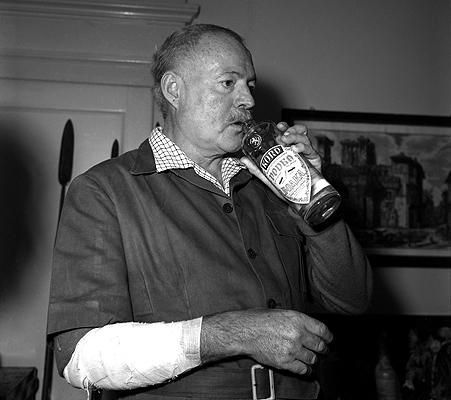A Literary Cities piece on drinking with Hemingway's Ghost. By Liam Pieper.
I’m the worst kind of tourist, in that I always manage to convince myself that making a few empty gestures when I’m on holiday – ordering breakfast in the local language, for instance, or wandering into a church and nodding appreciatively at the windows, perhaps, that I’m somehow elevated to the status of traveller. That I travel as some kind of rarefied nomad, rather than an antipodean drone shuffling through the Louvre to elbow my way close enough to take an iPhone photo of the Mona Lisa. 
This manifests in the grossest way whenever I’m in a new city and I find myself (inevitably) in a Hemingway bar. Half a century after his death, Hemingway remains the figurehead of a certain kind of literary drunk. He is an icon and, like all icons, his image is engraved on countless bars trying to make money off his cache. I’ve paid a frightful lot of money for bad drinks at bars whose branding is centred on the fact Hemingway once got tanked in them; I’ve drunk at Hemingway bars in New York, Paris, Florida, Barcelona, even Seoul—a city I’m pretty sure the man never visited. I’ve lost track of the number of times I’ve crossed a scary new city to sit in a kitsch bar and drink some nightmarish sugarwater based on something the storied drunk once ordered in Cuba, and I find myself wondering how I’ve managed to become, once again, a tributary to this weird hero worship.
It’s a bad habit, one I can’t seem to break. I’m writing this from The Hemingway Bar in Prague, sitting in a dark wood and stuffed armchair cocktail bar which, to be fair, is very, very nice, and doesn’t claim any direct relation to Hemingway, they are just inspired by his tastes in booze: rum, absinth and double-strong daiquiris.

There are dozens of bars around the world that pay homage to late writer to various degrees. In The Foridita, where Hemingway drank the 1940s and ’50s away, a life-sized bronze effigy of a pot-bellied Hemingway leans against the bar. Tourists file in, snap a photo, down a daiquiri and leave. There are at least two bars who claim to be the original Sloppy Joes (the dive bar Hemingway loved so much he acquired the urinal and turned it into a fountain on his property) and they’ve sued each other over naming rights.
In fact, more Hemingway bars proliferate by the year. Places he went to, or might have gone to, or were name-checked in his books, or were named after fictional places or the characters in them. And for some reason, I, and sycophants of my ilk, keep rocking up and ordering rum.
It’s a strange sort of homage, as though we are going to soak up some vital essence that eluded us in reading him. There’s something about the myth of Hemingway, a myth he spent a lifetime cultivating: hard drinking, tough talking, the taciturn front that hid his unimaginable depth, the way he drank all night and woke to work at his standing desk, his womanising, and his hunting. The man was a masterful writer, but also a genius marketer. By the time he won the Nobel Prize, the legend and the writing were indistinguishable. Once can’t parse the two any more than one can work out how the writing works.
Clean, accessible, deep, his writing is inimitable but everyone has a phase where they imitate him. Don’t believe any writer who says they haven’t tried to emulate Hemingway’s sparse style, any more than you would believe someone who says they don’t masturbate.
When I was younger and dumber, I emulated literary heroes who were, on balance, shitty people. I do not hunt, am not a card-carrying misogynist, and have no dreams of going to war, but for a long time I drank like Hemingway (also Keroac, Parker, Joyce—all the rest of the Saints), figuring that if I had a drinking problem, the talent would accrue. It took me way too long to realise I’d gotten it backwards, and one is never going to find their answers at the bottom of someone else’s bottle.
Of course, having said all that, the drinks at this bar are very, very good.
Cheers.

